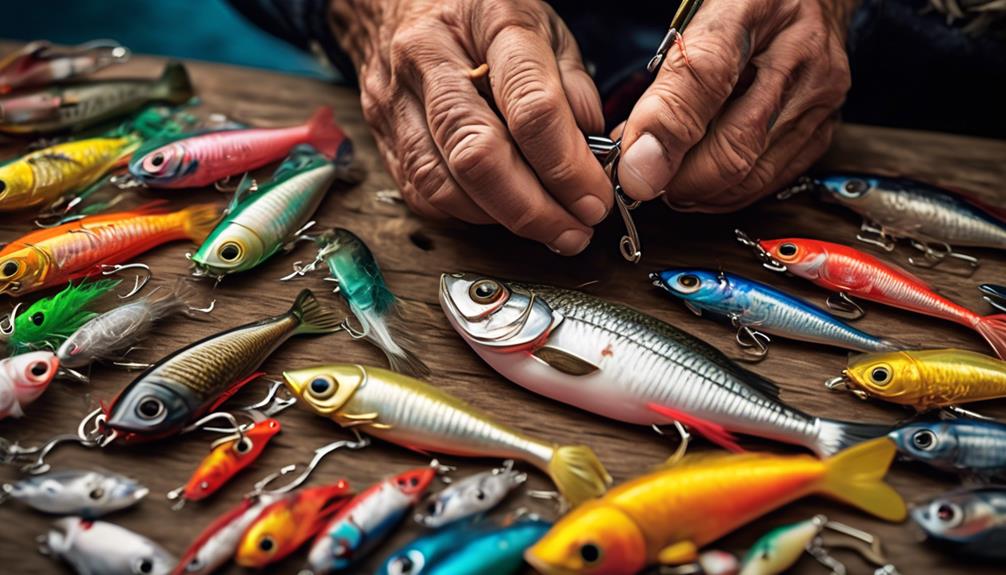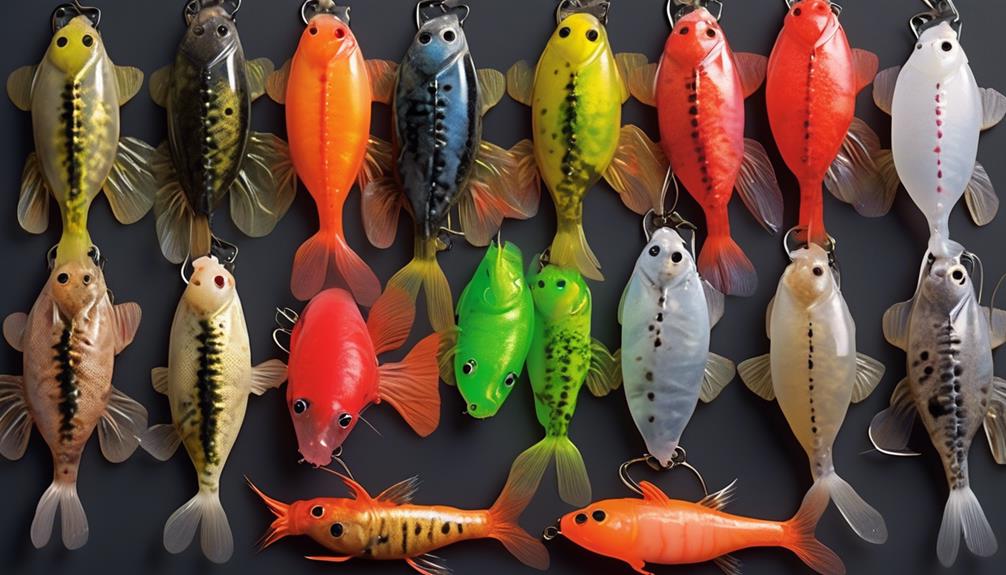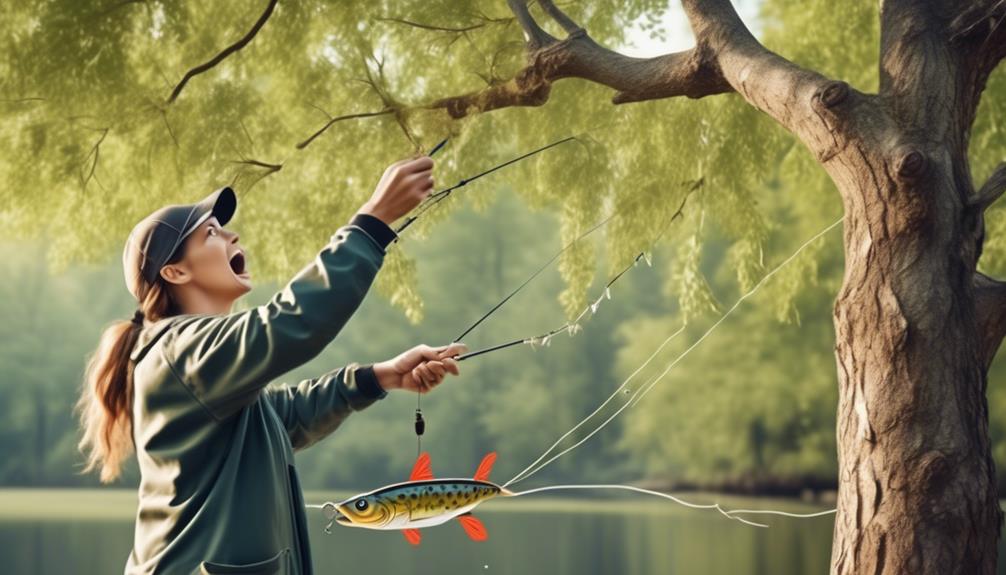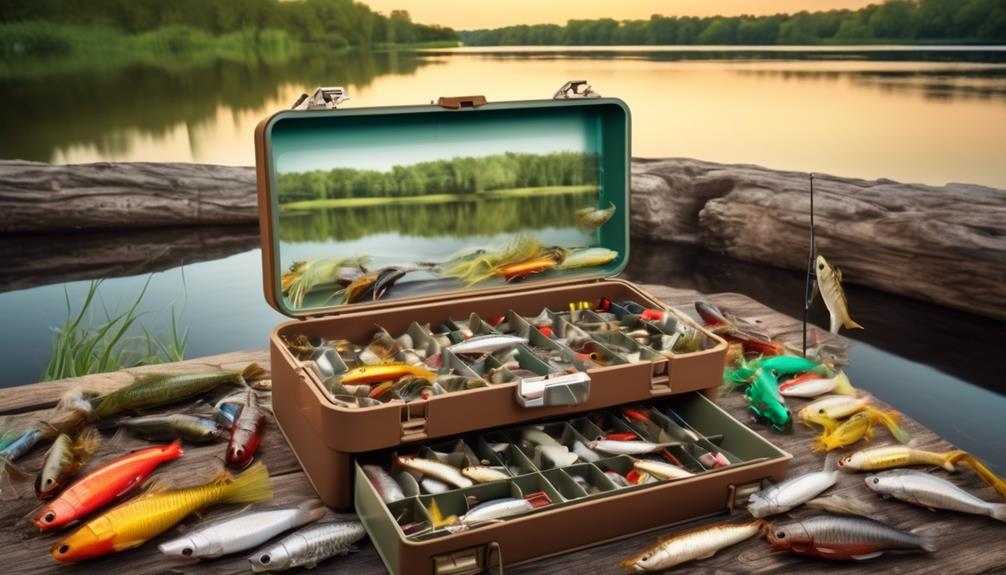You think you've got your fishing rigging game down, but let's face it – there's always room for improvement. Whether you're a seasoned angler or just starting out, mastering the art of bait and lure rigging is crucial for landing those elusive catches.
From the classic Texas Rig to the finesse of Wacky Rigging, there are techniques out there that can take your fishing game to the next level. So, if you want to reel in more success on your next fishing trip, it's time to explore the 10 best rigging techniques that will have you hooked from the get-go.
Texas Rigging
To properly Texas rig your bait or lure, you should begin by threading the bullet weight onto your line. This weight will help your bait sink and maneuver through heavy cover in shallow water, where fish often hide. Once the weight is on, tie a hook to the line.
The next step is to insert the point of the hook into the top of the bait and push it through until the hook is mostly concealed. This weedless rigging is essential for navigating through vegetation without getting snagged, making it perfect for fishing in areas with heavy cover.
When choosing a soft plastic bait for Texas rigging, consider the conditions and the behavior of the fish. In shallow water with lots of vegetation, a creature bait or a worm-style bait can be effective. The soft plastic bait should be durable enough to withstand multiple catches and have a natural movement in the water.
To further enhance the weedless nature of the Texas rig, you can add a plastic or glass bead between the weight and the hook to protect the knot and reduce the risk of line abrasion. This setup allows you to effectively present your bait in heavy cover without constantly getting hung up. Remember to adjust the weight size based on the depth and the density of the cover you're fishing.
Carolina Rigging
When moving from Texas rigging to Carolina rigging, you can adapt your approach to target fish in deeper waters and varying bottom structures. Carolina rigging offers several advantages, such as the ability to cover a large area and present the bait in a natural manner. It's particularly effective for fishing in deeper waters where the fish may be suspended off the bottom. Additionally, the Carolina rig allows for easy bait changes and reduces the chances of the fish detecting the angler's presence.
However, one of the drawbacks of Carolina rigging is that it can be more prone to getting snagged in heavy cover due to the leader line's length.
The best baits for Carolina rigging techniques include soft plastic creature baits, lizards, and worms. These baits mimic natural prey and can be rigged weedless to reduce the risk of getting caught in vegetation or other underwater obstacles. When using Carolina rigging, it's essential to focus on baits that have a lifelike action in the water, as this rig excels at creating a natural presentation. As you experiment with different baits, consider the water clarity, for example, using brighter colors in murky water and more natural tones in clear water.
Drop Shot Rigging
Consider using a variety of finesse baits when employing the drop shot rigging technique to entice finicky fish in clear or pressured waters. This finesse technique involves presenting the bait above the weight, allowing for precise depth control and enticing natural movements. Here are a few key points to keep in mind when drop shot rigging:
- Depth Control: The drop shot rig allows you to target specific depths by adjusting the length of the leader between the weight and the hook. This precise control is particularly effective when fish are holding at a specific depth or are suspended in the water column.
- Bait Selection: Opt for smaller, more subtle baits such as soft plastic worms, minnow imitations, or creature baits. These finesse baits exhibit natural movements and are less intimidating to wary fish, making them ideal for drop shot rigging.
- Subtle Movements: When using the drop shot rig, subtle movements are key. Gently shake the rod tip to impart lifelike action to the bait. The finesse presentation of the drop shot rig is designed to trigger cautious fish into striking.
- Sensitivity: The drop shot rig allows for enhanced sensitivity, making it easier to detect subtle bites. The weight resting on the bottom transmits even the slightest taps or movements up the line to the angler.
- Adaptability: The drop shot rig is versatile and can be used in various fishing environments, from deep water to shallow flats. Its adaptability makes it a valuable technique in the angler's arsenal.
Wacky Rigging
For a change of pace from drop shot rigging, let's shift our focus to wacky rigging, a versatile and effective method for presenting soft plastic baits to lure in finicky fish. Wacky rigging involves hooking a soft plastic bait through the middle, creating a tantalizing action that's irresistible to bass and trout.
One of the key benefits of wacky rigging is its ability to produce a natural, erratic action when the bait is twitched or allowed to sink. This can be particularly enticing to fish in clear or heavily pressured waters, where a more subtle presentation is needed.
However, wacky rigging does have its drawbacks. The exposed hook can make it more prone to snags in heavy cover, and the bait may not stay on the hook as securely as with other rigging methods. To mitigate this, using o-rings or specialized wacky rigging tools can help improve bait longevity and reduce snags.
When targeting bass, wacky rigging can be highly effective in both shallow and deep waters. The subtle movements of the bait can trigger strikes from even the most hesitant bass.
For trout, wacky rigging can be a game-changer, especially when fishing in streams or rivers with varying current speeds.
Jig Head Rigging
Jig head rigging offers anglers a versatile and effective method for presenting soft plastic baits to entice a wide range of fish species. When using this technique, you'll find that the weighted hook provides the necessary balance for casting and retrieving your soft plastic bait, making it an ideal choice for enticing fish in various conditions.
Here are some key points to consider:
- Versatility: Jig head rigs can be used in both freshwater and saltwater environments, allowing you to target different species such as bass, walleye, trout, redfish, and snook. The adaptability of this rig makes it a valuable addition to any angler's arsenal.
- Natural Presentation: The weighted hook helps the soft plastic bait to sink in a natural manner, mimicking the movement of real prey. This can trigger more strikes from predatory fish, enhancing the overall fishing experience.
- Effective for Cover: Jig head rigs are particularly useful for fishing around structures or cover such as rocks, docks, and vegetation. The weighted hook enables you to navigate these areas with greater precision, increasing your chances of landing a catch.
- Depth Control: The added weight of the jig head allows for better control over the depth at which you present your bait. This feature is especially advantageous when targeting fish at specific depths or in varying water conditions.
- Minimal Snagging: The streamlined design of the jig head minimizes the risk of getting snagged, allowing you to focus on fishing with confidence and reducing frustrating interruptions.
Topwater Lure Rigging
When rigging a topwater lure, carefully select the appropriate knot to ensure secure attachment and optimal movement in the water. The key to successful topwater lure rigging lies in maximizing surface action and mastering presentation techniques.
Start by choosing a strong and reliable knot, such as the Palomar knot, that will keep your lure securely in place during aggressive surface strikes. This knot also allows for the freedom of movement necessary to create enticing surface action.
In addition to the knot, consider the presentation techniques that will bring your topwater lure to life. Incorporate a variety of retrieval methods, such as the walk-the-dog technique, to mimic the erratic movements of injured baitfish. This can trigger explosive strikes from predatory fish lurking beneath the surface. Experiment with different speeds and pauses to find the presentation technique that entices the most aggressive strikes.
When rigging a topwater lure, it's crucial to pay attention to the details. Ensure that the knot is cinched tightly to the lure to prevent any unnecessary movement that could hinder its action. By mastering the art of topwater lure rigging, you can create an irresistible presentation that will lure in even the most wary fish.
Spinnerbait Rigging
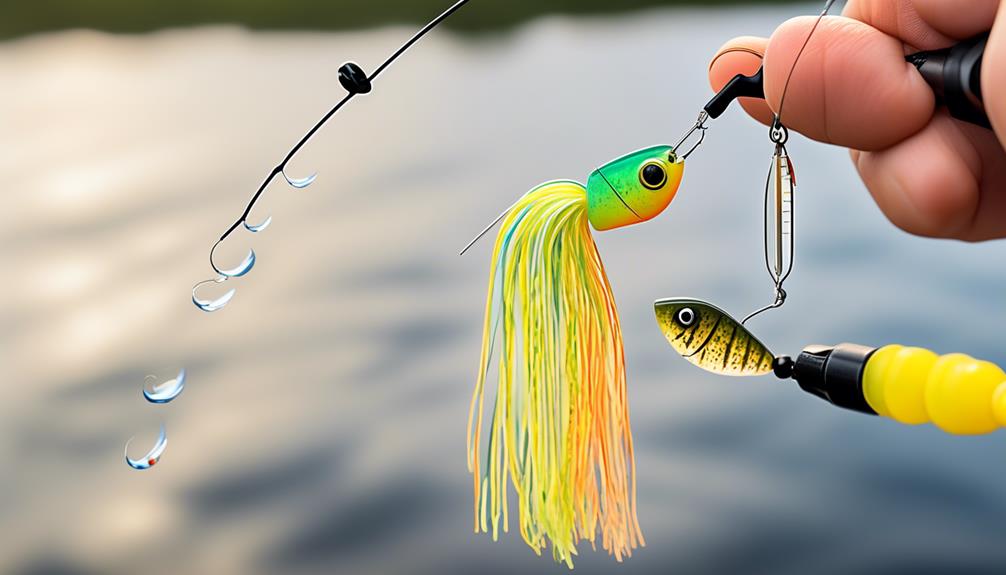
After mastering the art of topwater lure rigging, you can now shift your focus to the effective rigging of spinnerbaits to entice strikes from predatory fish. Spinnerbaits are versatile lures that can be used in various fishing environments, making them a popular choice among anglers.
To maximize your success with spinnerbaits, consider the following techniques and tips:
- Vary Your Retrieval Speed: Experiment with different retrieval speeds to determine the most effective technique for attracting fish. Sometimes a slow, steady retrieve is best, while other situations may call for a faster, erratic retrieve to trigger strikes.
- Utilize Trailer Selection: The selection of a spinnerbait trailer can significantly impact its performance. Adding a trailer, such as a soft plastic grub or swimbait, can enhance the lure's action and appeal to fish.
- Pay Attention to Water Depth: Adjust the weight of your spinnerbait based on the water depth you're fishing in. Lighter spinnerbaits work well in shallow waters, while heavier ones are more suitable for deeper areas.
- Experiment with Blade Combinations: Spinnerbaits come with different blade configurations, each producing a distinct vibration and flash. Experiment with various blade combinations to find the most enticing option for the fish in your target area.
- Use Color to Your Advantage: Consider the water clarity and light conditions when selecting spinnerbait colors. In murky water, bright and bold colors may be more visible, while natural hues are often preferred in clear water.
Swimbait Rigging
To rig a swimbait effectively, consider the weight and size of the bait in relation to the fishing conditions and the behavior of the target fish. Swimbait presentation is crucial for enticing fish, and understanding swimbait retrieval techniques can significantly improve your chances of a successful catch.
When selecting a swimbait, it's essential to match the size and weight of the bait to the prevailing fishing conditions. In clear water with minimal cover, a smaller, more natural-looking swimbait may be ideal, while in murky water or areas with heavy cover, a larger, more robust swimbait might be more effective. The behavior of the target fish should also influence your choice of swimbait. For example, if the fish are feeding near the surface, a topwater swimbait would be suitable, whereas a sinking or deep diving swimbait may be better for fish that are holding deeper.
Once you've chosen the right swimbait, mastering swimbait retrieval techniques is essential. Vary your retrieval speed to find the most effective presentation. Sometimes a slow, steady retrieve is best, while other situations may call for a stop-and-go or erratic retrieve to mimic injured prey. Experiment with different retrieval techniques until you find the one that triggers the most strikes.
Frequently Asked Questions
Can I Use the Same Rigging Technique for Both Freshwater and Saltwater Fishing?
You can use the same rigging technique for both freshwater and saltwater fishing, but it's important to consider the specific conditions. Different rigging methods for various depths and types of fish are crucial.
In saltwater, you may need to adjust for stronger currents and larger species. Adapting your rigging to the specific environment will improve your chances of success.
Freshwater rigging may require lighter setups for smaller fish and shallower depths. Adapting your rigging to the specific environment will improve your chances of success.
How Do I Know When to Use a Weedless Rigging Technique?
When fishing in weedy or snaggy areas, knowing when to use a weedless rigging technique is crucial. Weedless rigging benefits you by preventing your bait or lure from getting caught in vegetation or other obstacles.
Techniques for avoiding snags include using weedless hooks or Texas rigging soft plastics. By employing these methods, you can fish confidently in areas with heavy vegetation or cover without constantly getting stuck.
Are There Any Special Considerations for Rigging Bait and Lures in Heavy Current or Fast-Moving Water?
When you're rigging in fast water, it's crucial to use weighted lures to maintain control. Adjust your bait presentation to adapt to heavy current, and consider specialized rigs.
Using scent attractants can also help increase your chances of a successful catch. Keep these factors in mind to ensure that your bait and lures are effectively rigged for fishing in heavy current or fast-moving water.
What Are the Best Rigging Techniques for Targeting Specific Fish Species, Such as Bass, Trout, or Walleye?
When targeting specific fish species like bass, trout, or walleye, the key lies in lure selection and presentation techniques. Pay attention to the type of bait and the retrieval methods that work best for each species.
Experiment with different rigging techniques to find what works for you. Remember, successful fishing isn't just about the bait, but also about how you present it to the fish.
Are There Any Advanced Rigging Techniques That Can Help Me Catch More Fish in Challenging Conditions, Such as Deep Water or Low Visibility?
When rigging for deep water and night fishing, it's crucial to use low visibility finesse rigging techniques.
In challenging conditions, such as deep water or low visibility, consider using glow-in-the-dark lures or adding rattles to your bait for attracting fish.
Additionally, consider downsizing your bait and using lighter line to finesse rig for cautious fish in these conditions.
These advanced techniques can help you catch more fish when fishing in challenging environments.
Conclusion
So there you have it, 10 of the best techniques for rigging your fishing bait and lures.
Whether you prefer Texas rigging, Carolina rigging, or any of the other methods mentioned, it's important to choose the right technique for the type of fishing you're doing.
With these techniques in your arsenal, you'll be ready to tackle any fishing situation and increase your chances of a successful catch.
Happy fishing!
